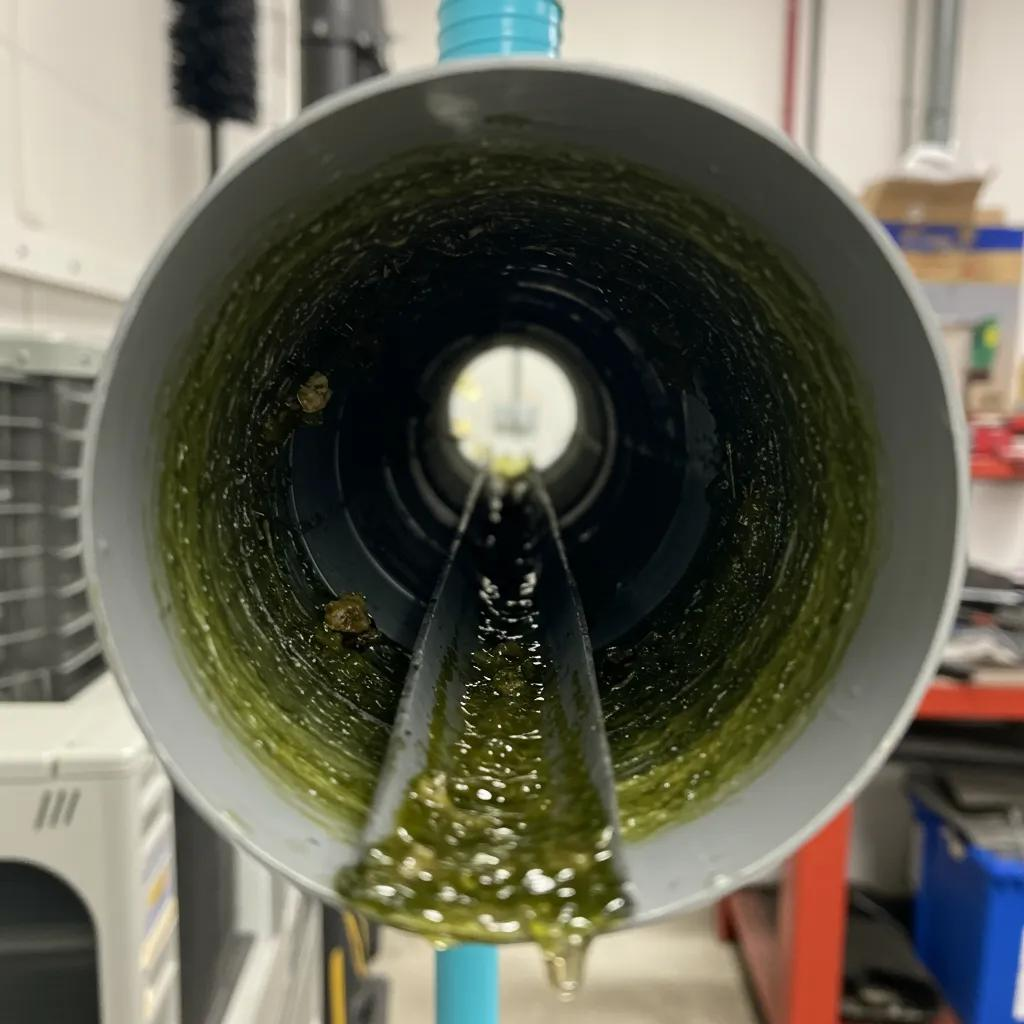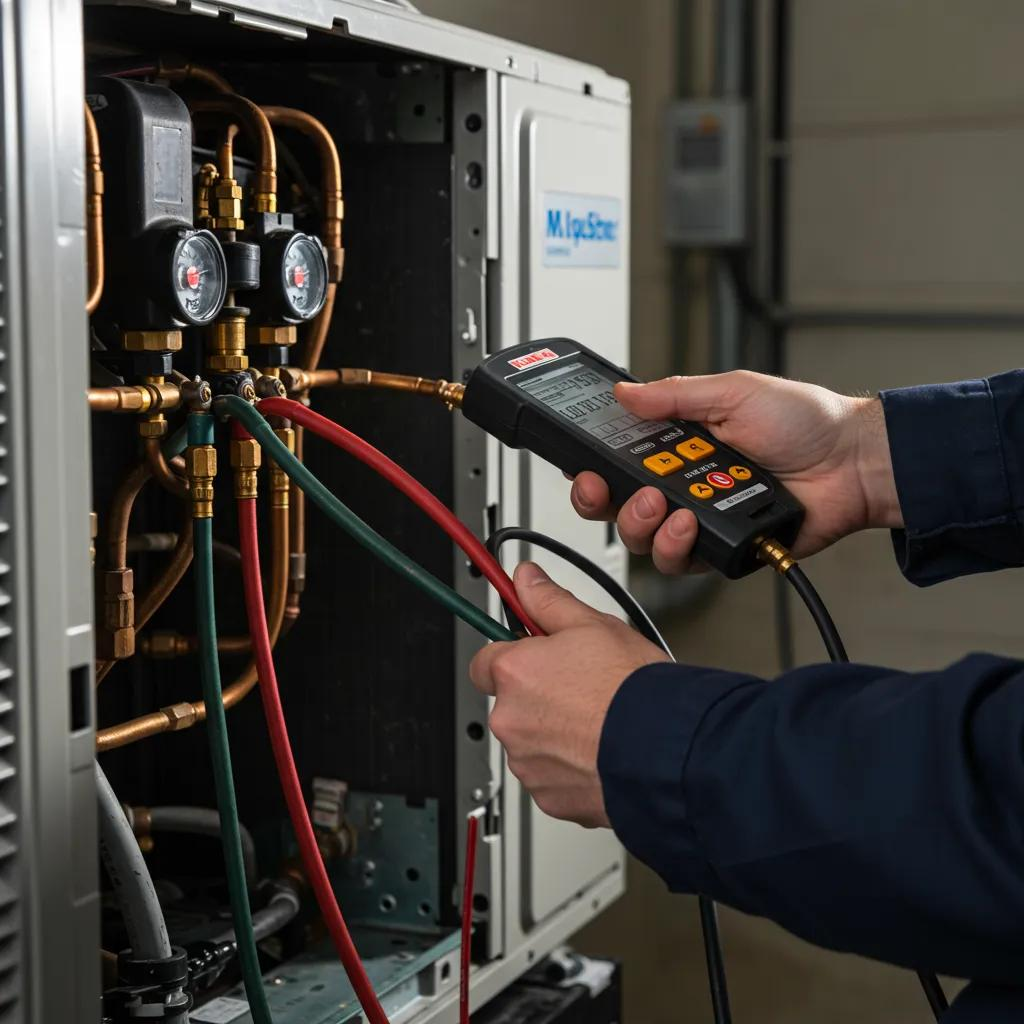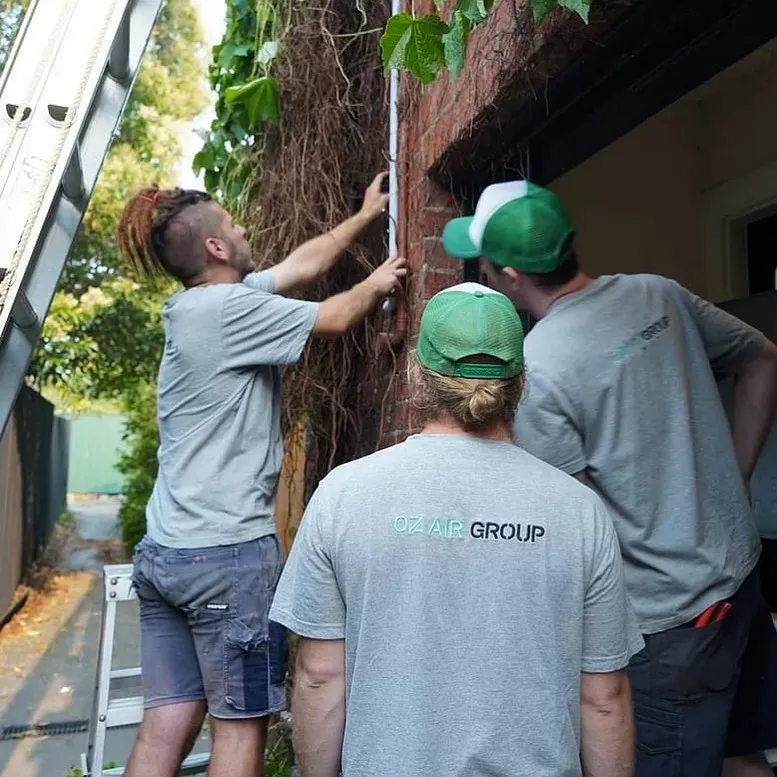Air Conditioning Leaking Water: Reasons, and Things To do


Government Rebates Now Available on Energy-Efficient Air Conditioners when Replacing your Gas Heater.
A dripping air conditioner can signal serious issues that compromise comfort, indoor air quality, and even structural integrity. Addressing a water leak promptly restores performance and prevents mold growth, water damage, and energy waste. In this guide you’ll discover why indoor water leaks happen, how to troubleshoot and repair common issues yourself, when to enlist Oz Air group’s expert technicians, and strategies to keep your system leak-free. We’ll cover condensation basics, primary leak causes, DIY fixes, professional intervention criteria, refrigerant leak identification, maintenance practices, cost expectations, and what makes Oz Air group the trusted choice for AC leak solutions.
Why Is My Air Conditioner Leaking Water Inside? Common Causes Explained
Understanding internal condensation helps differentiate normal drainage from problematic leaks. Air handlers cool humid air and condense moisture on the evaporator coil; the condensate drain line and pan should channel that water safely away. When any component falters, overflow or back-up occurs and water spills into living spaces instead of the drain.
What Is a Clogged AC Drain Line and How Does It Cause Water Leaks?

A clogged AC drain line occurs when algae, mold and debris accumulate inside the condensate pipe, blocking gravity-fed drainage and causing water to back up into the unit. As condensation collects on the evaporator coil, the excess moisture has nowhere to go and spills over the drain pan. Regular flushing prevents pipe obstruction, improves airflow around the coil, and ensures consistent drainage.
How Does a Frozen Evaporator Coil Lead to Water Leakage?
A frozen evaporator coil forms when low refrigerant levels or poor airflow cause the coil temperature to drop below freezing, turning condensation into ice. Once the system shuts down or warms up, that ice rapidly melts, overwhelming the drain pan and producing flooding inside the air handler. Keeping filters clean and refrigerant at optimal levels avoids coil freezing and subsequent overflow.
What Are the Signs of a Damaged Drain Pan Causing Leaks?
A cracked or rusted condensate pan fails to contain condensation, allowing water to drip onto the surrounding cabinet and onto flooring. Early signs include visible cracks or corrosion spots under the evaporator coil, a steadily forming puddle beneath the air handler, and inconsistent drainage noise. Replacing a compromised pan restores proper containment and prevents water damage.
How Do Dirty Air Filters Contribute to AC Water Leaks?
Clogged filters reduce airflow across the evaporator coil, dropping coil temperature and increasing condensation volume. Restricted air movement allows moisture to freeze on the coil and melt irregularly, causing overflow. Installing fresh filters monthly maintains balanced airflow, prevents coil icing, and stops water from bypassing the drain pan.
Evaporator Coil Airflow and Maintenance in Air Conditioning Systems
This process included the modification or expansion of grilles, the replacement of contaminated filters, and the cleaning of the evaporator coil. Subsequent inspection indicated that air leakage within the return ductwork between the return grille and the coil was negligible.Impact of evaporator coil airflow in residential air-conditioning systems, RA Raustad, 1997
Can Low Refrigerant Levels Cause My AC to Leak Water?
Low refrigerant reduces heat-exchange efficiency and leads to excessively cold evaporator coils that freeze up. When the ice melts after shutdown, the sudden volume of water can exceed the drain pan’s capacity. Only certified technicians should add refrigerant; proper charge levels eliminate freezing cycles and the associated leaks.
What Other Factors Cause AC Water Leaks?
- Disconnected or misaligned drain lines that fail to route condensate into the p-trap.
- Broken condensate pumps unable to push water through pipes in slab-mount installations.
- Damaged insulation on refrigerant lines leading to excess condensation dripping.
- Improper installation angles that prevent full drainage of the evaporator coil.
Identifying these less frequent causes often requires professional inspection to restore correct drainage geometry and component function.
How to Fix AC Water Leaks: DIY Solutions and When to Call a Professional
How Do I Clear a Clogged AC Drain Line Step-by-Step?
Begin by turning off power to the indoor blower at the thermostat and electrical panel to prevent water-induced shocks. Locate the drain line overflow access near the indoor unit and attach a wet/dry vacuum to the outlet end. Run the vacuum for two to three minutes to extract debris, then flush the line with a cup of distilled white vinegar followed by warm water to sterilise and dissolve algae buildup. Restoring clear flow in the drain line stops backups and water intrusion.
What Is the Process to Replace a Dirty Air Filter?
Replacing an air filter starts with switching the AC off and opening the filter compartment along the return air duct. Remove the old pleated filter and note its size printed on the frame. Slide in a new high-efficiency filter (MERV 8–13) in the airflow direction marked on the side. Closing the compartment and restarting the system restores proper airflow and prevents coil icing.
How Can I Clean the Evaporator Coil to Prevent Leaks?
Cleaning the evaporator coil reduces ice formation and improves condensation management. After shutting off power, remove the air handler access panel and gently brush dust from the coil fins. Apply a no-rinse foaming coil cleaner, allowing it to penetrate and loosen embedded dirt. Rinse residue by running the AC briefly, condensate will carry away loosened debris. A clean coil maintains optimal heat exchange and avoids excessive condensation.
When Should I Contact Oz Air group for Professional AC Leak Repair?
Oz Air group’s technicians are best suited for complex leaks involving damaged drain pans, broken condensate pumps, low refrigerant, or unknown sources. If your AC continues to leak after DIY steps, exhibits irregular cycling, or shows signs of refrigerant issues such as hissing noises or ice on coils to schedule a professional service. Certified interventions ensure accurate diagnosis, safe handling of refrigerants, and long-term leak resolution.
What Emergency Steps Should I Take If My AC Is Leaking Water?
First, turn off the air conditioner at both the thermostat and the breaker to halt further leakage. Place towels or a shallow pan under the drip area to contain water and protect flooring. Use a wet/dry vacuum or towels to remove standing water inside the unit. Then call Oz Air group’s emergency hotline for rapid response, preventing structural damage and mold growth until a technician arrives.
How to Identify and Repair AC Refrigerant Leaks: Symptoms, Dangers, and Costs
What Are the Common Symptoms of an AC Refrigerant Leak?
Refrigerant leaks manifest through reduced cooling output, warm air blowing from vents, and unexplained spikes in energy bills. A distinct hissing or bubbling near refrigerant lines indicates escaping gas, while frost or ice buildup on evaporator coils signals a low-charge condition. Detecting these warning signs early prevents compressor damage and system shutdowns.
Why Are Refrigerant Leaks Dangerous for Health and Environment?
Refrigerants are classified as chemical substances that can displace oxygen in confined spaces and irritate respiratory passages. Many older refrigerants, such as R-22, contribute to ozone depletion, while newer variants still pose global warming potential if vented. Safe detection and containment by certified professionals protect indoor air quality and comply with EPA regulations.
How Does Oz Air group Detect and Repair Refrigerant Leaks?

Oz Air group employs advanced electronic leak detectors and fluorescent dye tests to pinpoint the source of refrigerant escape with precision. Once located, our technicians solder or replace the compromised section of copper tubing, pressure-test the repair, and evacuate moisture before recharging the system to exact manufacturer specifications. This systematic approach restores cooling efficiency and seals leaks permanently.
What Are the Typical Costs for Refrigerant Leak Repair and Recharge?

Higher line-set replacement or hard-to-access leaks may increase labor costs. Transparent pricing from Oz Air group ensures you know exact repair and recharge charges before work begins.
How Can Preventative AC Maintenance Help Stop Water Leaks?
Why Is Regular AC Servicing Important for Leak Prevention?
Scheduled inspections identify developing blockages, minor corrosion, and early refrigerant loss before they escalate into leaks. Professional tune-ups include coil cleaning, drain line flushing, and safety control checks that sustain optimal condensation management. Consistent servicing also aligns with warranty requirements and promotes energy-efficient operation.
How Often Should I Replace My Air Filter to Avoid Leaks?
Replacing filters every 30 days in high-usage seasons and every 60–90 days otherwise maintains airflow and prevents coil freezing. High-efficiency pleated filters trap finer particles and preserve indoor air quality while balancing drag on the blower. A simple filter swap is one of the most effective measures against water leaks.
What Is the Best Way to Maintain and Flush AC Drain Lines?
Technicians recommend biannual drain line flushing using a specialised pump or wet/dry vacuum combined with a safe biocide solution. Clearing algae, mold, and scale deposits supports unobstructed flow and prevents future clogs. Incorporating drain pan inspection into each service call ensures early detection of pan damage.
How Does Proper AC Installation Prevent Water Leaks?
Accurate installation sets the correct slope on refrigerant lines, positions drain pans under coils, and secures fittings to avoid stress cracks. Ensuring indoor units are level and the condensate line connects reliably to a p-trap avoids leaks at source. Professional installation from Oz Air group lays a solid foundation for leak-free performance.
What Does It Cost to Repair AC Water and Refrigerant Leaks?
What Are the Average Costs for AC Water Leak Repairs?

How Much Does Refrigerant Leak Repair Typically Cost?
As detailed earlier, refrigerant leak repair and recharge for R-410A averages $250–$500, while legacy R-22 systems run $400–$800. Complex repairs involving line-set replacement or manifold evacuations may push total costs toward the higher end of those brackets.
When Should I Consider Repairing vs. Replacing My AC Unit?
If repair costs exceed 50 % of a new high-efficiency system price, or if the unit is over 10–12 years old with multiple performance issues, replacement often yields better long-term value. Modern units offer improved energy ratings and more reliable leak-prevention designs, offsetting initial investment with lower operating costs.
What Makes Oz Air group the Trusted Choice for AC Leak Repairs?
How Do Oz Air group’s Expert Technicians Diagnose and Fix AC Leaks?
Oz Air group’s technicians combine infrared cameras, electronic leak detectors, and proprietary inspection protocols to isolate leak sources swiftly. Once identified, they apply precision soldering, component replacement, and exact refrigerant charging to restore systems to factory specifications, maximising reliability.
What Preventative Maintenance Programs Does Oz Air group Offer?
Comprehensive service plans include biannual tune-ups, seasonal filter replacement, coil cleaning, drain line flushing, and priority emergency responses. Members benefit from discounted repair rates, extended service warranties, and alerts for system health preventing leaks before they occur.
How Does Oz Air group Handle Emergency AC Leak Repairs?
With 24/7 emergency availability, Oz Air group teams arrive equipped to contain water damage, secure electrical safety, and implement temporary drainage solutions. Rapid response minimises interior flooding and mold risk until permanent repairs are completed.
What Is Oz Air group’s Transparent Pricing Policy for Leak Repairs?
Every service call begins with a no-obligation inspection and a detailed repair estimate outlining parts, labor, and refrigerant costs. Flat-rate options and itemised invoices ensure homeowners understand exactly what they pay for, no hidden fees or surprise charges.
Frequently Asked Questions About Air Conditioning Leaking Water
Why Is My AC Leaking Water Even When It’s Turned Off?
Residual condensation trapped in the evaporator coil or drain pan can continue to drip after shutdown if the drain line remains blocked. Gravity will eventually force this water out of the drip pan. A thorough line flush and pan inspection eliminate standing moisture and stop post-shutdown leaks.
Can I Fix an AC Water Leak Myself or Should I Hire a Professional?
Simple leaks caused by clogged drain lines or dirty filters can often be resolved with DIY flushing, a wet/dry vacuum, and filter replacement. However, leaks from damaged pans, refrigerant issues, or unknown sources require professional assessment to ensure safe, permanent repairs.
How Does High Humidity Affect AC Water Leaks?
Excessive indoor humidity increases condensation volume on the evaporator coil, potentially overwhelming a partially blocked drain line or undersized pan. Maintaining humidity below 60 % with dehumidifiers and ensuring clear drainage paths prevents overflow and water damage.
What Are the Health Risks of Mold from AC Water Leaks?
Persistent moisture fosters mold and mildew growth in ductwork and drip pans, releasing spores that can irritate respiratory pathways, trigger allergies, and aggravate asthma. Prompt leak repair and regular maintenance protect indoor air quality and occupant health.
How Long Does It Take to Repair an AC Water Leak?
Minor drain line cleanings and filter changes typically take 30–60 minutes. Pan replacements or condensate pump repairs may require 2–3 hours, depending on access. Refrigerant leak detection and recharging can extend service to a half-day. Oz Air group’s efficient workflows minimise downtime and restore cool comfort quickly.
Leaky air handlers threaten both comfort and home integrity, but routine maintenance and timely repairs preserve reliable cooling performance. By understanding causes such as from clogged drain lines to refrigerant loss, you can address minor issues yourself and know when to enlist Oz Air group’s certified technicians for complex work. Regular servicing, prompt attention to warning signs, and clear cost guidance ensure your system remains efficient and leak-free year after year. Trust Oz Air group’s expertise to keep your air conditioner running smoothly without water worries.
Areas we service
Oz Air covers Melbourne and its northern suburbs.

Get in touch






.png)









.png)